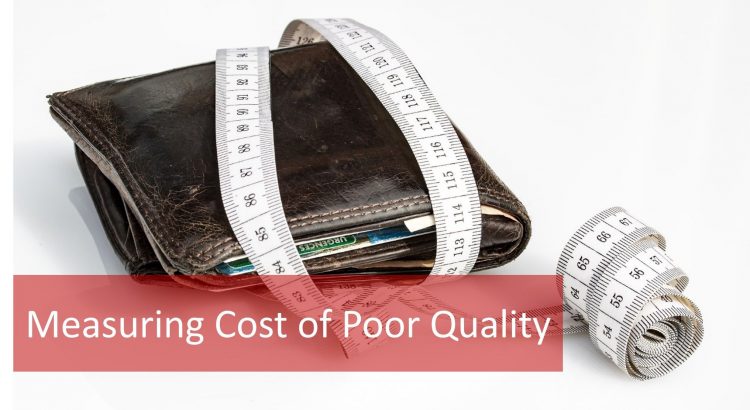What is Cost of Poor Quality (COPQ) or Cost of Quality (COQ)? The Cost of Quality, abbreviated as COQ, is just another term for Cost of Poor Quality, abbreviated as COPQ. Let us briefly try to understand what COPQ means according to Six Sigma principles. It is another common metric used for Six Sigma projects as discussed in Lean training course. These are the costs which are associated with providing poor quality products or services. In other words, COPQ is the costs that would disappear if systems, processes, and products were perfect.
Attend our 100% Online & Self-Paced Free Six Sigma Training.
Every time work is redone, the cost of quality increases. If the COPQ is the metric used by the Six Sigma team to baseline the current state, they should refer to a financial expert in the company for help. Each company may calculate COPQ differently.
COPQ – costs towards preventing poor quality
As briefly explained in free Six Sigma Green Belt Certification training COPQ or Cost of Poor Quality Six Sigma is actually a methodology that allows an organization to determine the extent to which its resources are used for activities that prevent poor quality, that appraise the quality of the organization’s products or services, and that result from internal and external failures. Having such information allows an organization to determine the potential savings to be gained by implementing process improvements.
COPQ: Types of Quality Costs
There are four categories of Quality Costs to consider in COPQ. These are as follows:
- Internal Failure Costs
- External Failure Costs
- Appraisal Costs
- Prevention Costs
Let us have a look at each category one-by-one.
Internal Failure Costs
The first type of COPQ is Internal Failure Costs. These costs are incurred to remove defects discovered before the product or service is delivered to the customer. These costs occur when the results of a work fail to reach design quality standards and are detected before they are transferred to the customer.
Internal Failure Costs can include:
- Waste: Performance of unnecessary work or holding of stock as a result of errors, poor organization, or communication
- Scrap: These are defective products or material that cannot be repaired, used, or sold
- Rework or rectification: It refers to correction of defective material or errors
- Failure analysis: It is an activity required to establish the causes of internal product or service failure

External Failure Costs
The second category of COPQ is External Failure Costs. External Failure Costs are incurred to remedy defects discovered by customers. These costs occur when products or services that fail to reach design quality standards are not detected until after they were transferred to the customer.
External Failure Costs can include
- Repairs and Servicing: The sub category relates to both returned products and those sold in the field
- Warranty Claims: These are the failed products that are replaced or services that are re-performed; under a guarantee or warranty
- Complaints: It refers to all work and costs associated with handling and servicing customers’ complaints
- Returns: It relates to handling and investigation of rejected or recalled products, including transport costs
Appraisal Costs
The third category of COPQ is Appraisal Costs. Appraisal costs are associated with measuring and monitoring activities related to quality. These costs are associated with the suppliers’ and customers’ evaluation of purchased materials, processes, products and services to ensure that they conform to specifications.
Appraisal costs can include:
- Verification: It refers to checking of incoming material, process setup, and products against agreed specifications
- Quality audits: The activity assures that the quality system is functioning correctly
- Supplier rating: It is an assessment and approval of vendors of products and services
Prevention Costs
The fourth category of COPQ is Prevention Costs. Prevention costs are incurred to prevent or avoid quality problems. These costs are associated with the design, implementation, and maintenance of the quality management system. They are planned and incurred before the actual operation.
Prevention Costs can include:
- Product or Service Requirements: These are the costs incurred related to the establishment of specifications for incoming materials, processes, finished products, and services
- Quality Planning: The expenses incurred for the creation of plans for quality, operations, production, and inspection
- Quality Assurance: The cost related to creation and maintenance of the quality mechanism
- Training: The costs associated with development, preparation, and maintenance of programs
COPQ Calculations
The quality costs, under COPQ, are calculated to assign a dollar figure to some defects produced by a process. Cost of Poor Quality calculation is performed after collecting defect data to gauge the impact of those defects on profitability.
The following method of calculation is used to quantify COPQ for any type of error, defect or mistake:

1. Count the number of incidents over a period of time (once, per day, per week). The activity simply refers to gauging the occurrence
2. Determine the labor cost associated with fixing the number of incidents (reworking, storing, retrieving, etc.). The generic formula for calculation would be: Number of defectives per day * Number of people who work in the area * Hours worked per day * Hourly pays for the time period. This formula will help you calculate labor cost generically. Please note that formula may differ from industry-to-industry or company-to- company
3. Determine the material cost for the defects. The generic formula for calculating the final COPQ would be Cost per item used * Quantity defective per annum. This formula will help you calculate the material cost generically. Please note once again that formula for determining COPQ may differ from industry-to-industry or company-to-company
4. Add the totals from steps 2 and 3.
And that’s how you get your COPQ!
COPQ is a handy way of determining what an inefficient process is costing your company. If the COPQ is high, then it is a perfect reason to launch a Six Sigma process improvement project to reduce the COPQ. If a business has highly efficient processes in place to deliver products or services that customers want, the COPQ should not be a problem – the business would not be producing low-quality products. Six Sigma projects are designed to reduce quality problems in processes. Knowing your COPQ for your process is the perfect starting block for a Six Sigma project.
Review by: Victoria Miller


